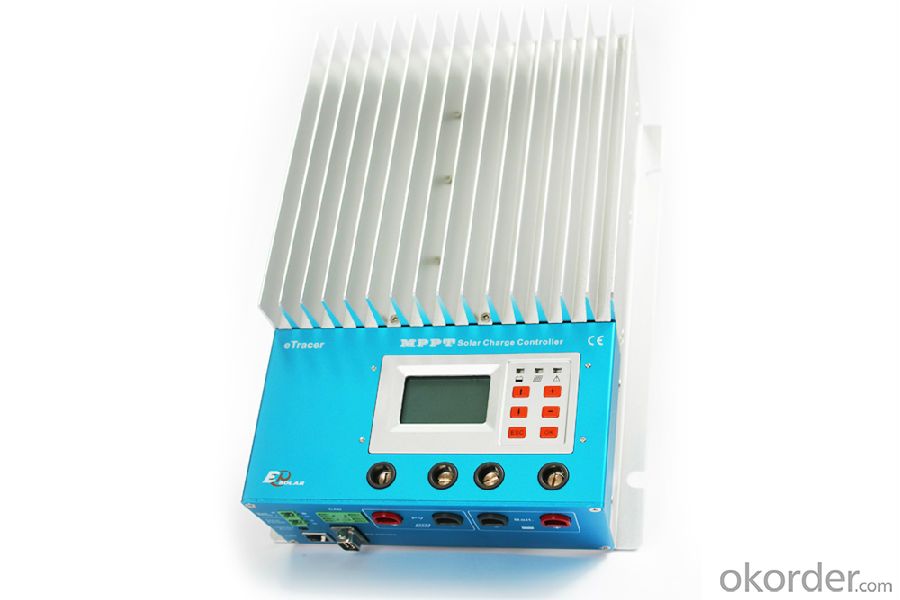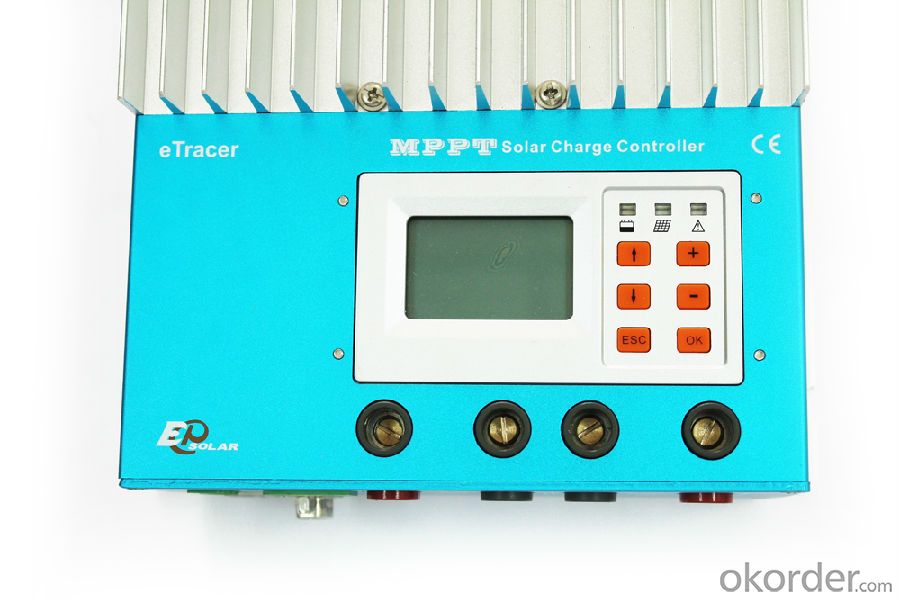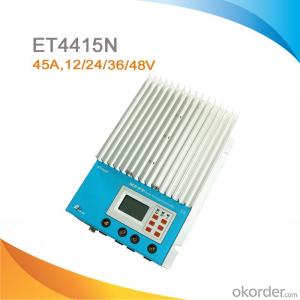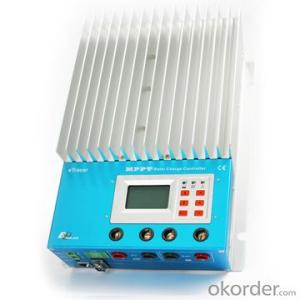MPPT Solar Street Light Charge Controller 45A,12/24/36/48V,ET4415N
- Loading Port:
- China main port
- Payment Terms:
- TT or LC
- Min Order Qty:
- -
- Supply Capability:
- -
OKorder Service Pledge
OKorder Financial Service
You Might Also Like
Specifications
MPPT charge controller
Maximum power point tracker
temperature compensation
LCD display
Communicate with PC
Features:
·12/24/36/48V auto work
·Advanced MPPT technology
·Several seconds tracking speed
·High Tracking efficiency of 99%
·Multiphase synchronous rectification technology
·Peak conversion efficiency of 98%
·DSP&ARM processors architecture ensures high speed and performance
·Gel, Sealed, Flooded battery option
·Max. 450 days data logging by connection to PC
·Multifunction LCD displays system data and status
·Three kinds of communication ports :RS232, CAN BUS and Ethernet
·Three stages charging optimizes battery performance
·Software update by users
Specification:
Model | ET3415N | ET4415N | ET6415N |
Rated system voltage | 12V/24V /36V/48V auto work | ||
Rated battery current | 30A | 45A | 60A |
Max. PV open circuit voltage | 150V | ||
Voltage range | 8~72V | ||
Max.PV input power | 400W (12V) | 600W (12V) | 800W (12V) |
800W (24V) | 1200W (24V) | 1600W (24V) | |
1200W (36V) | 1800W (36V) | 2400W (36V) | |
1600W (48V) | 2400W (48V) | 3200W (48V) | |
Self-consumption | 1.4~2.2W | ||
Grounding | Negative | ||
Dimension | 231x203x105mm | 285x203x105mm | 285x203x121mm |
Terminal | 35mm2 | 35mm2 | 35mm2 |
Net Weight | 4.1kg | 4.4kg | 5.0kg |
Working temperature | -25℃~+55℃ | ||
Storage temperature range | -30℃~+85℃ | ||
Humidity | 10%-90% NC | ||
Enclosure | IP20 | ||
Altitude | ≤3000m | ||



FAQ:
Q1. What is the voltage?
A1. Our 45/60A solar charge controller is 12/24/36/48V auto work.
Q2. What is the difference between MPPT&PWM?
A2. MPPT has higher efficiency, it can track the max power point and won't waste energy.
Q3. What is the efficiency of the MPPT controller?
A3. MPPT>99%, peak conversion efficiency>98%.
Q4. What is the waranty of product?
A4. 12 months.
Q5. What protection does your MPPT controller have?
A5. PV array short circuit, PV reverse polarity, Battery reverse polarity, Over charging, Output short circuit.
- Q:Can a solar controller be used in harsh weather conditions?
- Yes, a solar controller can be used in harsh weather conditions. Most solar controllers are designed to be weather-resistant and can withstand various environmental conditions such as extreme temperatures, rain, snow, and high winds. However, it is always recommended to check the specifications and guidelines provided by the manufacturer to ensure the controller is suitable for the specific harsh weather conditions it will be exposed to.
- Q:Can a solar controller be used in a mobile solar system (e.g., RV, boat)?
- Yes, a solar controller can be used in a mobile solar system such as an RV or boat. A solar controller helps regulate the charging process of the batteries and prevents overcharging, which is crucial in maintaining the health and longevity of the batteries in a mobile solar system.
- Q:How does a solar controller handle variations in load power requirements?
- A solar controller handles variations in load power requirements by constantly monitoring the power output from the solar panels and adjusting the charging current accordingly. When the load power requirement increases, the solar controller increases the charging current to meet the demand. Similarly, if the load power requirement decreases, the solar controller reduces the charging current to prevent overcharging. This dynamic adjustment ensures that the load power requirements are met efficiently while maintaining the optimal charging conditions for the batteries.
- Q:Can a solar controller be used with solar-powered RVs or boats?
- Yes, a solar controller can be used with solar-powered RVs or boats. A solar controller regulates the charging process of the batteries in these vehicles, ensuring that they are charged optimally and preventing overcharging or damage. It helps to control the flow of solar power from the panels to the batteries, making it an essential component for efficient solar power utilization in RVs or boats.
- Q:Can a solar controller be used with a solar-powered bus stop?
- Yes, a solar controller can be used with a solar-powered bus stop. A solar controller regulates the power output from the solar panels to ensure efficient charging and protection of the batteries. It is an essential component in managing and controlling the energy flow in a solar-powered system, including a bus stop.
- Q:How does a solar controller handle high voltage spikes or surges?
- A few different methods are employed by a solar controller to handle high voltage spikes or surges. To begin with, most solar controllers are equipped with built-in overvoltage protection. This means they can endure higher voltages than their rated capacity without sustaining damage. This protective feature safeguards the controller against voltage spikes that may occur during thunderstorms or other electrical disruptions. Furthermore, solar controllers often utilize surge protection devices, such as varistors or transient voltage suppressors. These devices are designed to redirect excessive voltage away from the controller, preventing it from being overwhelmed by sudden surges. Moreover, certain solar controllers incorporate voltage clamping circuits that restrict the voltage to a safe level. These circuits serve as a safety measure by ensuring that the voltage does not exceed a specific threshold, even in the event of a spike or surge. In conclusion, the combination of overvoltage protection, surge protection devices, and voltage clamping circuits enables a solar controller to effectively manage high voltage spikes or surges. By absorbing, redirecting, or limiting the excess voltage, the solar controller ensures the safety and durability of the connected system.
- Q:How does a solar controller handle high current flow from the solar panels?
- A solar controller, also known as a charge controller, plays a crucial role in regulating the flow of current from the solar panels to the battery bank. It ensures that the batteries receive the correct amount of charge and prevents overcharging or damage to the batteries. When high current flows from the solar panels, the solar controller manages this by utilizing a few key mechanisms. Firstly, it employs a pulse width modulation (PWM) or maximum power point tracking (MPPT) technique to efficiently convert the high current generated by the solar panels into the appropriate voltage and current required for charging the batteries. In the case of a PWM controller, it rapidly switches the connection between the solar panels and the battery bank on and off, controlling the flow of current and voltage to match the battery's requirements. This method effectively regulates the charging process and prevents excessive current from reaching the batteries. On the other hand, MPPT controllers employ advanced algorithms and circuitry to track the maximum power point of the solar panels, optimizing the energy conversion process. These controllers can handle high current flow by adjusting the voltage and current to maintain the maximum power output from the panels, resulting in more efficient charging of the batteries. Additionally, solar controllers incorporate various safety features to handle high current flow. They typically have built-in protections such as overcharge protection, short-circuit protection, and reverse polarity protection. These safeguards ensure the system remains safe and prevents any damage to the solar panels, batteries, or other connected components. In summary, a solar controller effectively handles high current flow from the solar panels through techniques such as PWM or MPPT, optimizing the energy conversion process. It also incorporates safety features to protect the system and ensure the batteries receive the appropriate charge without any risk of damage.
- Q:How does a solar controller handle the protection against electrical surges?
- A solar controller handles protection against electrical surges by incorporating surge protection devices and transient voltage suppressors. These devices are designed to divert or limit excess voltage and current caused by surges, preventing damage to the controller and connected solar equipment. Additionally, some solar controllers may also feature built-in circuitry that monitors and regulates voltage levels to ensure safe operation and protect against surges.
- Q:How does a solar controller prevent over-discharging of batteries?
- A solar controller prevents over-discharging of batteries by monitoring the voltage level of the batteries and disconnecting the load when it reaches a predetermined low level. This prevents the batteries from being drained beyond their safe operating range, which can lead to damage and reduce their overall lifespan.
- Q:Can a solar controller be used with solar-powered outdoor recreational equipment?
- Yes, a solar controller can be used with solar-powered outdoor recreational equipment. A solar controller helps regulate the charging and discharging of batteries in solar-powered systems, including outdoor recreational equipment such as solar-powered lights, camping gear, or portable speakers. It ensures that the batteries are charged efficiently and protected from overcharging or discharging, thereby optimizing the performance and lifespan of the equipment.
1. Manufacturer Overview |
|
|---|---|
| Location | |
| Year Established | |
| Annual Output Value | |
| Main Markets | |
| Company Certifications | |
2. Manufacturer Certificates |
|
|---|---|
| a) Certification Name | |
| Range | |
| Reference | |
| Validity Period | |
3. Manufacturer Capability |
|
|---|---|
| a)Trade Capacity | |
| Nearest Port | |
| Export Percentage | |
| No.of Employees in Trade Department | |
| Language Spoken: | |
| b)Factory Information | |
| Factory Size: | |
| No. of Production Lines | |
| Contract Manufacturing | |
| Product Price Range | |
Send your message to us
MPPT Solar Street Light Charge Controller 45A,12/24/36/48V,ET4415N
- Loading Port:
- China main port
- Payment Terms:
- TT or LC
- Min Order Qty:
- -
- Supply Capability:
- -
OKorder Service Pledge
OKorder Financial Service
Similar products
New products
Hot products
Hot Searches
Related keywords































